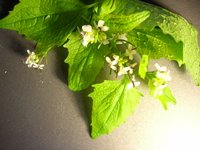
With much concern I discovered Garlic Mustard [Alliaria petiolata (Bieb.) Cavara & Grande] on our property last night for the first time. It took hold in a patch along the eastern edge of our driveway presumably carried in by the dirt on the tires or on the car. For the time being the contamination seems to be confined to a roughly circular area no more than three metres (10 feet) across. This morning I have pulled all the flowering plants from the patch and will now watch it diligently. I also noticed stalks of the plant that probably grew there last year. There are many rosettes that have taken hold in small garbage can lid sized clearings.
The book Ontario Weeds (reprinted February, 2001), By J.F. Alex, published by Ontario Ministry of Ariculture, Food and Rural Affairs, to order see www.gov.on.ca/omafra ) devotes a full page on the plant. It states that Garlic Mustard only reproduces by seed so I will watch the flower development and keep plucking them.
For more info there are many websites on this invasive weed such as: http://www.omafra.gov.on.ca/english/crops/hort/news/hortmatt/2005/10hrt05a4.htm
The flower of the Garlic Mustard is easily recognised by its small white cross shape as in the photograph here. The flowers in this photo range from 8mm to 10 mm. (approx. 5/16 to3/8 in.) across.
In the urban parts of the City of Ottawa especially downtown this invasive weed has completely taken over the gardens especially in the greenspace areas along the edge of the river. I am curious to know what the City or the National Capital Commission – custodian for much of Ottawa’s greenspace – are going to do about it. It has spread there to epidemic proportions and in time I fear that it will spread out to here to a degree where it will no longer be manageable. In other words it will start creeping in from the neighbouring lots which are uninhabited and which I have no control over.
Garlic Mustard will completely take over ground cover areas in forests and choke out natural indigenous species. Thus it has a very negative effect on forest biodiversity. Also a recent article claims that the plant kills fungi in the ground that are essential for the growth of trees such the Sugar Maple. For a story on this see: http://www.680news.com/news/national/article.jsp?content=n051404A
This plot was weedable but I was still not able to remove all the rosettes. They are quite small and planted among rocks which is hard to get at. Some of the larger plants broke off at the root since the roots were firmly embedded among the rocks. I will watch them to see if they will sprout.
Let’s hope that it will be a long time before more of this scourge really arrives.
No comments:
Post a Comment